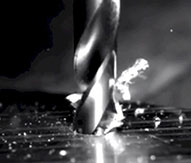Eliminating Chatter: BlueSwarf To The Rescue?
 Chatter, the vibration created when CNC machine tooling engages a work piece, affects turning, milling, and drilling operations, but is especially troublesome for milling. Even minimal chatter can shorten tool life and impact part quality. Too much chatter can even damage machine tools.
Chatter, the vibration created when CNC machine tooling engages a work piece, affects turning, milling, and drilling operations, but is especially troublesome for milling. Even minimal chatter can shorten tool life and impact part quality. Too much chatter can even damage machine tools.
With many manufacturers performing higher speed cutting, chatter may be intensified and more difficult to control. Carefully thought-out part programming can help eliminate many chatter problems, however fine tuning the relationship between the tooling and work piece has often been accomplished “by ear,” relying on the ability of the machine operator to detect the chatter zones and compensate for them. This subjective practice, of course, requires a great deal of time-consuming trial and error.
That’s where BlueSwarf comes in. This Internet-based system described as a “stability improvement technology” uses a special hammer equipped with a transducer to tap the tool and holder assembly mounted in the machine tool. The hammer device records the frequency response for the unique tool, holder, spindle and machine combination. This data is encrypted and sent through the Internet for analysis. The result is posted to a dashboard that the machine operators can view on their computer screens, and which graphically presents the precise stable speeds, feed rates, width and depth of cut for the operation.
By taking the guesswork out of chatter elimination, machine users save significant time while ensuring optimum throughput, reduced tool wear and improved part quality. For a 2-1/2 minute explanation of the BlueSwarf process, visit . For more about BlueSwarf, contact the applications experts at Gosiger, Inc.
 |